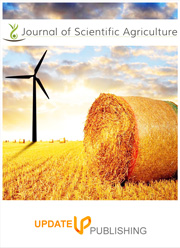Soil test crop response based phosphorous calibration study on maize at Abay Choman district, Horo Guduru Wollega zone, Oromia region, Ethiopia
DOI:
https://doi.org/10.25081/jsa.2023.v7.7639Keywords:
Abay Choman, Calibration, Maize and PhosphorusAbstract
Soil test crop response-based P calibration study can give farmers more economic use of fertilizers and better soil management practices. In a view of this, the trial was done in the Abay Choman district on ten experimental farmers’ fields in the first year of the experiment (2018/19 cropping season) to determine the economic rate of N and on twenty farmers’ fields in the second and third years of the experiment (2019/20 and 2020/21 cropping season respectively) to determine phosphorus critical level and requirement factor. In the first year of the experiment, the treatments were combined in factorial with four levels of phosphorus (0, 10, 20, 40 kg/ha) and four levels of nitrogen (0, 46, 92 and 138 kg/ha). While experiments in the second and third years of the experiment were six levels of Phosphorus 0, 10, 20, 30, 40 and 50 kg/ha. The treatments were laid out as a randomized complete block design (RCBD) with three replications. Representative soil samples were taken before planting and analyzed. Experimental sites that have a pH of < 5.5 were amended using the lime application before the setup of the experiment. Soil test results of the study sites before planting indicated that pH values of most soils were strongly acidic (<5.5) and available phosphorus of experimental soil ranged from 3.22 to 13.62 pp. The main effects of both N and P significantly influenced the mean grain yield of maize, but their interaction was not significant with a grand mean of 76.53 qt/ha during the N determination trial. Economic analysis using partial budget analysis showed 92 kg/ha of N was economically optimal for the production of maize in the Abay Choman district. The study also showed that P- the critical value (12 ppm) and P- the requirement factor (10.55 Kg P/ha) were determined for the phosphorus fertilizer recommendation in the study area. Thus, the farmers in the area might be advised to use soil test crop response-based fertilizer recommendations to increase the productivity of maize in and around the study district.
Downloads
References
Abdissa, G., Girma, A., & Wilfred, M. (1999). Maize Seed systems study in western Shewa and eastern Wellega zones of Oromia Region. Addis Ababa, Ethiopia: CIMMYT Technical Paper, ILRI.
Bacha, D., Aboma, G., Gemeda, A., & Groote, H. D. (2001, February). The determinants of fertilizer and manure use in maize production in Western Oromiya, Ethiopia. Seventh Eastern and Southern Africa Regional Maize Conference Proceedings.
Bekele, T., Gorfu, G., Assen, Y., & Sertsu, S. (2002). Results of phosphorus soil-test calibration study in Hetosa Wereda, Arsi Zone. Proceeding of the workshop on phosphorus soil test alibration study Hetosa Wereda, Arsi Zone, EAIR, Addis Ababa, Ethiopia.
Belette, T. (2014). Fertility Mapping of Soils of Abay Chomen District, Western Oromia, Ethiopia. Master Thesis, Haramaya University.
Chude, V. O., Jayeoba, O. J., & Oyebanyi, O. O. (2005). Hand book on soil acidity and use of agricultural lime in crop production (pp. 7-24). Nigeria: National Special Programme for Food Security.
CSA. (2013). Central Statistical Agency. Population Projection of Ethiopia for All Regions at Woreda Level from 2014 - 2017. Addis Ababa, Ethiopia.
Khan, A., Munsif, F., Akhtar, K., Afridi, M. Z., Zahoor, Ahmad, Z., Fahad, S., Ullah, R., Khan, F. A., & Din, M. (2014). Response of fodder maize to various levels of nitrogen and phosphorus. American Journal of Plant Sciences, 5(15), 2323-2329. https://doi.org/10.4236/ajps.2014.515246
Mamo, T., & Haque, I. (1987). Phosphorous status of some Ethiopian soils. Sorption characteristics. Plant and Soil, 102, 261-266. https://doi.org/10.1007/BF02370713
Mengistu, A. (2004). Country Pasture/Forage Resource Profiles of Ethiopia. Rome, Italy: Food and Agricultural Organization of the United Nations (FAO).
Solomon, D., Lehmann, J., Mamo, T., Fritzsche, F., & Zech, W. (2002). Phosphorus forms and dynamics as influenced by land use changes in the sub-humid Ethiopian highlands. Geoderma, 105(1-2), 21-48. https://doi.org/10.1016/S0016-7061(01)00090-8
Sonon, L. S., & Zhang, H. (2014). Soil test calibration work in southern USA. Texas A&M University.
Published
How to Cite
Issue
Section
Copyright (c) 2023 Temesgen Chimdessa, Chalsissa Takele, Garamu Bayeta, Firaol Gemada, Rafisa Leta

This work is licensed under a Creative Commons Attribution-NonCommercial-NoDerivatives 4.0 International License.



 .
.